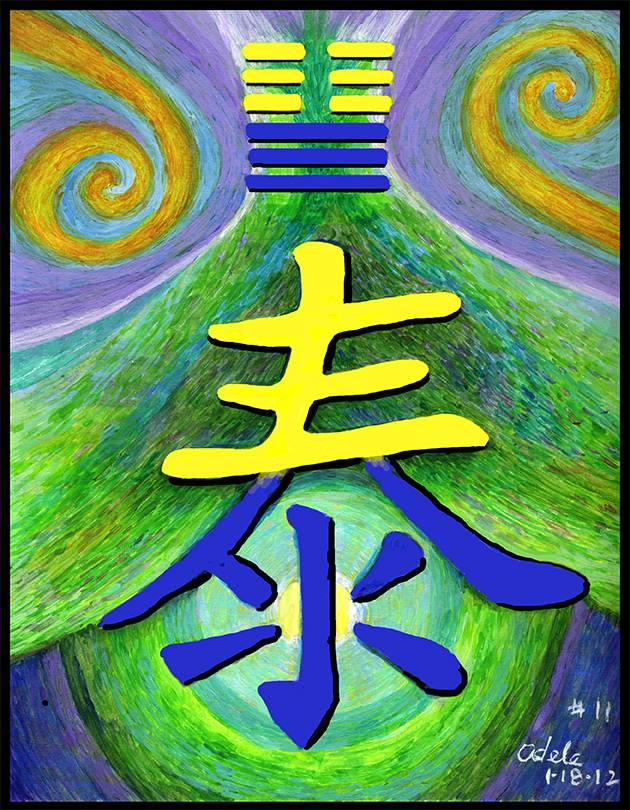I rarely see anything about the I Ching in the mainstream media. But the other day, I ran across an article worth mentioning.
But first, a bit of explanation. The I Ching has been around for at least 5,000 years, but was introduced to a larger Western audience in 1950 through the translation of Richard Wilhelm, a European who spent most of his life translating ancient Chinese texts. Carl Jung wrote the introduction to the text in 1949, the first time he publicly defined his theory of synchronicity.
Jung contended that divination fell under the broad umbrella of synchronicity. When you ask a question and toss the coins, the resulting hexagrams are a reflection of an inner condition.
The system is based on 64 patterns known as hexagrams, which are derived by tossing three coins six times. Bones originally were used and later, stalks of yarrow. Hexagrams consist of 6 horizontal lines, either broken or unbroken. Using coins, heads (yang) equals 3 points and tails (yin) equals 2. So, 3 heads and a tail would equal 8. Both 6 and 8 are broken lines; 7 and 9 are unbroken. In addition, 6s and 9s are “changing lines,” which suggest the present situation is in flux. So a 6- broken line – would change to solid line and a 9 – an unbroken line – would change to a broken line and you would have a new hexagram, the evolution of your question.
As Jung wrote in his introduction, whoever invented the I Ching believed the hexagram was “the exponent of the moment in which it was cast.” In other words, you ask a question, toss the coins, and the hexagram(s) you receive is like a snapshot in time, a manifestation of an internal condition.
The McKenna brothers wrote about the I Ching in their book The Invisible Landscape: Mind, Hallucinogens, and the I Ching. They considered the 64 hexagrams to be archetypes of the human condition.
There are plenty of websites and blogs that deal with the I Ching and there are a fair number of free apps, too. One of the best websites is that of Adele Aldridge. But you don’t usually find much about the system in traditional venues like magazines and newspapers. So I was delighted when I dropped by Raw Story the other day and found one of the top stories is from The Guardian, entitled, I Ching: the Ancient Chinese Book of Wisdom at the Heart of Every Computer.
The writer, Demien Walter, begins by talking about how the I Ching influenced Gottfried Wilhelm von Liebniz, a mathematician in the late 1600s, who discovered the model for a new math in the heart of this ancient divination system.
“The I Ching represents the binary poles of reality as Yin and Yang. Like 1 and 0, these are abstract concepts that can represent the poles of any binary set, but in the text of the I Ching are often discussed as female and male…the I Ching was far more ambitious than the current applications of binary code, even in the most powerful supercomputer. The 64 hexagrams…claim to represent nothing less than the archetypal situations of human life itself.”
He goes on to explain that in the philosophy of the I Ching, reality isn’t entirely real, it’s more like a dream or an illusion. Perhaps it’s rather like the movie The Matrix, where Keanu Reeves “wakes up” and realizes that he’s been living in a vat of liquid, connected to hoses and tubes, and that the earth has been taken over by aliens.
“This dream of reality arises from the binaries of Yin and Yang, as they play out their infinite combinations. It’s not surprising then, from the I Ching’s perspective, that anything in the dream of reality can be represented as a model of its binary constituents, I a string of 1s and 0s, processed by a computer.”
“The real question,” Walter writes, “is can we wake up from the dream we’re in already?”
+++
I asked Adele Aldridge if f I could use her illustration for this post. It depicts an image for hexagram 11, in the I Ching. Peace. It’s one of my favorite hexagrams. Adele is illustrating each of the 64 hexagrams, a daunting task- and a labor of love.









For many years I used the I Ching as a guide, using a set of 16 pebbles to cast a hexagram, in four different colors: 7 orange, 5 white, 3 grey, and 1 bloodstone. I also had Wilhelm’s book to interpret them. One day I realized I had lost some of the stones and felt I could not cast another hexagram. For awhile I tried to use coins, but it just wasn’t the same. I still remember some of them very well, and Hexagram 11, Peace, was always a wonderful thing to receive. Thanks for this post, I’m off to discover Adele’s website. 🙂
16 pebbles! I love it. You’ll have to explain how that worked in terms of the hexagrams!
I find that the OSHO Tarot 1 card layout works for me much like the I CHing – I have the deck but here is a link that does the same thing https://www.osho.com/zen_tarot/mod/paradox-zen-tarot
Thanks for the link, Sharon! I have an I Ching app that I love!
Awakening from the dream is perhaps similar to Gurdjieff’s philosophy. We can’t escape our ‘prison’ until we realise we are in prison – or something like that!
It sounds like The Matrix, too!
Thanks for the mention here Rob and Trish. I am SO glad that you posted about that article. It was one of those that I thought I should do on my I Ching page and now I don’t have to. Perhaps I will post a mention of it there and link it back to your good discussion here.
I love what you’re doing with these illustrations of yours!